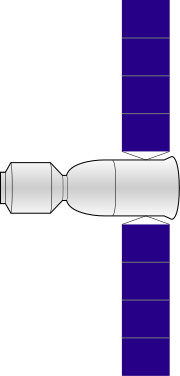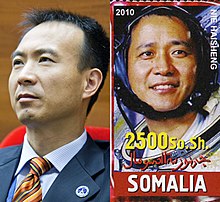 Diagram of the Shenzhou capsule-stack, without deployed orbit module solar cells | |
| Operator | |
|---|---|
| COSPAR ID | 2005-040A |
| SATCAT no. | 28879 |
| Mission duration | 4 days, 19 hours, 33 minutes |
| Orbits completed | 76[1] |
| Spacecraft properties | |
| Spacecraft type | Shenzhou |
| Crew | |
| Crew size | 2 |
| Members | |
| Start of mission | |
| Launch date | October 12, 2005, 01:00:05.583 UTC |
| Rocket | Chang Zheng 2F |
| Launch site | Jiuquan LA-4/SLS-1 |
| End of mission | |
| Landing date | October 16, 2005, 20:33 UTC |
| Landing site | Amugulang pasture, Hongger Township Siziwang Banner, Inner Mongolia[vague] |
| Orbital parameters | |
| Reference system | Geocentric |
| Regime | Low Earth |
 (L-R) Jùnlóng and Hǎishèng Shenzhou missions | |
Shenzhou 6 (Chinese: 神舟六号; pinyin: Shénzhōu lìuhào) was the second human spaceflight of the Chinese space program, launched on October 12, 2005, on a Long March 2F rocket from the Jiuquan Satellite Launch Center. The Shenzhou spacecraft carried a crew of Fèi Jùnlóng (费俊龙) and Niè Hǎishèng (聂海胜) for five days in low Earth orbit. It launched three days before the second anniversary of China's first human spaceflight, Shenzhou 5.
The crew were able to change out of their new lighter space suits, conduct scientific experiments, and enter the orbital module for the first time, giving them access to toilet facilities. The exact activities of the crew were kept secret but were thought by some to include military reconnaissance, however this is likely untrue given that similar experiments in the US and USSR determined that humans in space are not suited for military reconnaissance.[2] It landed in the Siziwang Banner of Inner Mongolia on October 16, 2005, the same site as the previous crewed and uncrewed Shenzhou flights.
- ^ "Shenzhou VI". China Manned Space. Archived from the original on 2020-10-01. Retrieved 2021-07-15.
- ^ Mark Wade. "Shenzhou 6". Encyclopedia Astronautica. Archived from the original on 2006-10-18. Retrieved 2006-09-19.